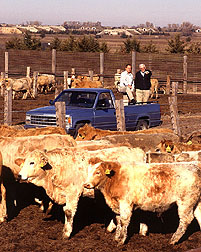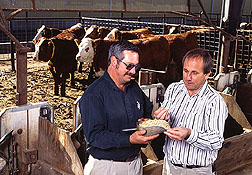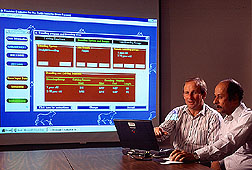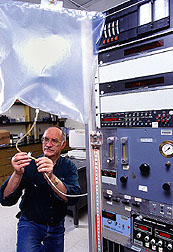DECI: Information Age Tool for the Cattle Industry
Change stares Jim McAdams in the face every day.
The fourth-generation cattleman from Lubbock, Texas, knows he must adapt to change if he's going to remain profitable. So he's among a cadre of beef industry people who recently checked out a new personal computer program for managing cattle.
McAdams says the computer model called DECI--Decision Evaluator for the Cattle Industry--may help him make the right decisions with the cattle he raises on Spade Ranches in Lubbock.
"The margin between profit and loss is getting tighter in all segments of the beef industry," he says. That means a single decision can easily make the difference between making or losing money.
Times have changed in the cattle business. More than a century ago, along routes such as the Chisholm Trail, drovers counted on unsettled country stretching from San Antonio, Texas, northward to provide abundant grass and water for cattle.
When the fattened cattle reached railcars at the trek's end--Abilene, Kansas--they'd have nearly doubled in value. And consumer demand back east was such that by the time the cattle reached Chicago for slaughter, their price would have nearly tripled.
Laws of supply and demand still reign for modern-day ranchers like McAdams, but management options are more complex.
"No longer can one simply assume increasing pounds of beef on the hoof will lead to profitability," says Thomas G. Jenkins, an Agricultural Research Service animal scientist at the Roman L. Hruska U.S. Meat Animal Research Center (MARC) in Clay Center, Nebraska.
Jenkins and cooperating researchers at Clay Center are trying to help McAdams and other cattle ranchers sort out management options that may help them produce beef that consumers want--at an acceptable price.
Complex Findings Simplified
The Chisholm Trail of halcyon days gave way to more extensive transportation systems and to settlers' barbed wire fencing. In today's information age, producers' roads to success may depend on applying a complex array of beef research findings to farms and ranches, each with its own set of resources. This is the idea behind DECI.
"Our goal is to keep improving decision support aids that people in the industry can use to think through choices, step by step," Jenkins says. "The computer ties several databases together in a way that lets producers use large amounts of information garnered from research without being overburdened by it."
Using a computer to pose a number of what-if questions could help producers avoid costly mistakes or missed opportunities that otherwise might not be recognized for years--if at all.
This approach strikes a resonant chord with McAdams. It's old hat for him, when considering purchase of a new bull, to use computerized databases to decide whether the animal is likely to increase the herd's average weaning weight. But the impact of one change can affect others.
Producers like McAdams ask, "What will happen to the grazing capacity of land stocked with more cows or with cows of a different breed that produce heavier calves? Will the extra grazing lower production over time?"
Fact-Based Decisions
For answers, McAdams selects questions and supplies relevant information to DECI in response to prompts. By entering information that includes historical management strategies, users of the model can consider changes that may help them better match genetics and feed resources to meet market demands.
Other questions DECI can address: Is the cost of harvested feeds impeding profitability? Would reducing the amount fed or breeding cows to calve earlier or later in a season make better use of forages available on the farm? As choices involving feed are made, what happens to cow conception rates, weaning weights, and the need for female replacements?
|
|
Answers to questions like these would be obscure without research on nutrition, genetics, breeding, or other problem areas that Clay Center scientists tackle. MARC animal scientist Calvin L. Ferrell's studies on cows' use of feed energy helped start the first computer modeling on beef production.
In the late 1980s and early 1990s, ARS researchers at three locations--Clay Center; Miles City, Montana; and El Reno, Oklahoma--began work on a model to show how feed energy can be converted most efficiently into lean beef.
Coordinated by MARC geneticist Gary L. Bennett, the model provided answers based on genetic traits and ages of the cattle. Beef cattle industry representatives then asked for a model that would further help breeders, producers, and feeders manage their operations, considering other research-based information.
The proposed model, later named DECI, would address the total beef production system. Charles B. Williams, an animal scientist who had developed much of the energy model, and colleagues found ways to incorporate their original work into the DECI project that Jenkins led. Additional elements going into DECI included research information on genetics, growth, body composition, and reproduction.
"We were excited by the scientists' enthusiastic response to the complex challenge, and the model was put together in just 2 years," says Barry Dunn, chairman of the National Cattlemen's Beef Association's (NCBA) subcommittee on production efficiency.
Based in Brookings, South Dakota, Dunn runs a cow-calf operation near there while pursuing a doctoral degree in animal husbandry at South Dakota State University. He is 1 of 20 producers, beef extension people, and consultants who evaluated the first version of DECI last spring. Since January 1998, the ARS scientists have made the new version available to other researchers. Soon, more general distribution will be handled by the NCBA. To run, DECI requires a personal computer with the Windows 95 operating system.
Change Will Be a Constant
DECI's designed to evolve continuously with updated research information related to productivity measurements, weights and carcass composition, and conception, calving, and weaning rates. Plans are under way to combine DECI with SPA, a standard production analysis that the NCBA uses to evaluate economic performance of cattle.
The model could eventually help producers evaluate costs versus returns for producing cattle suitable for marketing under a premium pricing system based on qualities such as meat leanness rather than on carcass weight.
Already the model can tell producers whether their feed resources are appropriate for cattle breeds that tend to produce less fat. Cattle with genetic leanness are not for every producer, Dunn points out, because thinner cattle may have curtailed reproduction. Not to worry, he adds, because sizable markets exists for both the leanest of beef and beef well marbled with fat.
Beef that's most popular with consumers has both marbling with tiny fat flecks characteristic of British breeds and the leanness characteristic of Continental European breeds, says Larry V. Cundiff. He heads the Genetics and Breeding Research Unit at MARC.
Researchers have shown that crosses with 50:50 ratios of Continental to British inheritance provide about the right balance. Projects are in progress at Clay Center and Miles City to assess other advantages and disadvantages of alternative mating systems using various breeds.
Meat can be quite lean, yet tender. Research led by MARC animal physiologist Mohammad Koohmaraie has shown marbling accounts for only about 10 percent of variation in tenderness among steaks. He and MARC food technologists Steven D. Shackelford and Tommy L. Wheeler have developed a way to help meat processors quickly identify carcasses most certain to yield beef cuts that are both lean and palatable.
Beef tenderness or toughness is controlled about 70 percent by environment and 30 percent by genetics. As researchers map out the active genes and develop tests to identify animals having them, DECI can be programmed to more precisely define impacts of genetic leanness and tenderness in individual herds.--By Ben Hardin, Agricultural Research Service Information Staff, 1815 North University Street, Peoria, IL 61604, phone (309) 681-6597.
Thomas G. Jenkins and other scientists mentioned in this article are at the USDA-ARS Roman L. Hruska U.S. Meat Animal Research Center, P.O. Box 166, State Spur 18D, Clay Center, NE 68933; phone (402) 762-4100, fax (402) 762-4148.
"DECI:Information Age Tool for the Cattle Industry" was published in the May 1998 issue of Agricultural Research magazine. Click here to see this issue's table of contents.










